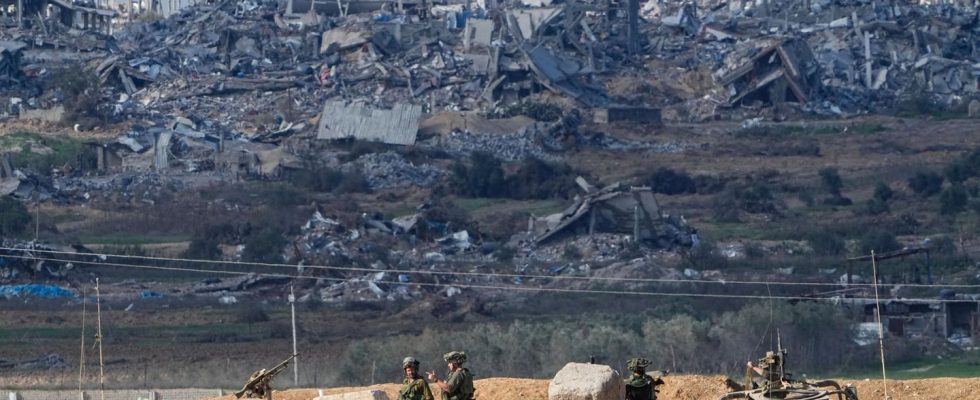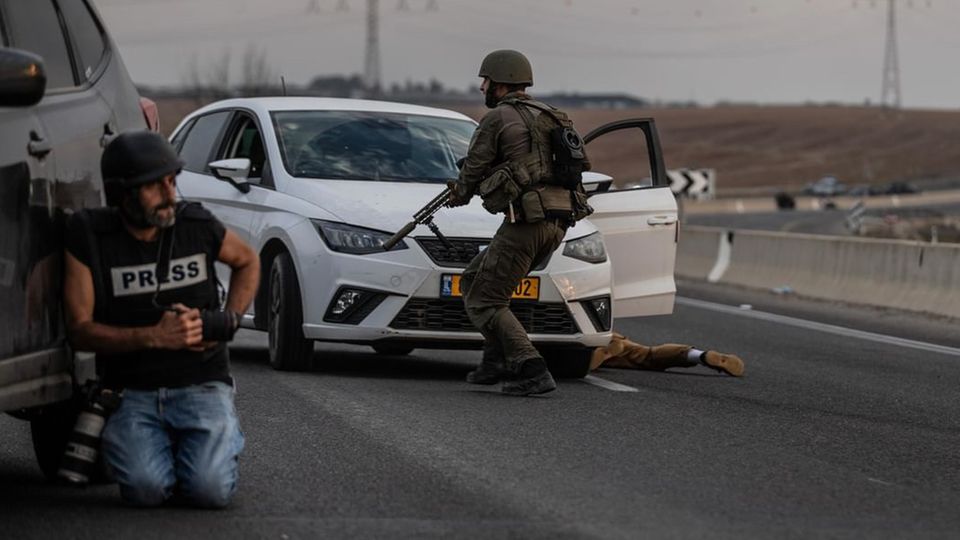War in the Middle East
Numbers of destruction: More than two-thirds of buildings in Gaza hit by war
Israeli soldiers take up positions near the border with the Gaza Strip
© Ariel Schalit/AP
A US media report provides frightening figures on the destruction in Gaza caused by the current war. The Israeli military now reports that it has captured Hamas’ headquarters in the south.
Almost three months after the start of the Gaza war, the coastal strip on the Mediterranean is now huge Destruction marked. As the “Wall Street Journal” reported on Saturday, citing the US intelligence agency US Office of the Director of National Intelligence (ODNI), Israel’s army had dropped 29,000 bombs on the sealed-off coastal area, which is barely larger than Munich, by mid-December alone . Almost 70 percent of the 439,000 houses and apartments in the Gaza Strip were damaged and destroyed, it said.
As the US newspaper further reported, citing a World Bank analysis, as of December 12, 77 percent of health facilities, 72 percent of municipal facilities such as parks, courts and libraries, 68 percent of telecommunications infrastructure and 76 percent of commercial areas had been damaged by the war damaged or destroyed, including the almost complete destruction of the industrial zone in northern Gaza.
More than 1.9 million people are internally displaced
“The word ‘Gaza’ will go down in history like Dresden and other famous cities that were bombed,” the newspaper quoted Robert Pape, a political scientist at the University of Chicago, as saying. According to the UN Emergency Relief Office, more than 1.9 million people are now internally displaced, i.e. around 85 percent of the population.
Israel repeatedly emphasizes that it is at war with Hamas and not with the civilians in the Gaza Strip. Measures are being taken to avoid the deaths of civilians. Residents are asked to leave affected areas before attacks. Hamas uses civilians as human shields and civilian buildings to hide entrances to underground tunnels. According to Israel, a number of Hamas terrorists are hiding in such tunnels and are also holding hostages from Israel there. The terrorists also use the tunnels to appear out of nowhere and attack from behind.
The war was triggered by the worst massacre in Israel’s history on October 7, in which terrorists from Hamas and other extremist groups murdered around 1,200 people in Israel and abducted around 240 others to the Gaza Strip. Israel responded with massive air strikes and a ground offensive. The government’s goal is the complete destruction of Hamas. The number of Palestinians killed in the Gaza Strip since the start of the war rose to 21,672, according to the Hamas-controlled health authority in Gaza. The number cannot currently be independently verified.
Israel storms Hamas headquarters in the south
Meanwhile, the Israeli army says it stormed the headquarters of the Islamist Hamas in Khan Yunis in the south of the Gaza Strip. The terrorist organization’s intelligence headquarters was also located there, Israeli army spokesman Daniel Hagari said on Saturday evening. The information could not be independently verified. Israel suspects that the leader of Hamas in the Gaza Strip, Jihia Sinwar, is hiding in the underground tunnels under Khan Yunis. The armed forces are currently intensifying the fight against Hamas, concentrating primarily on the south of the coastal area and the central Gaza Strip.
Attack on Hezbollah in Lebanon ended
In the north of the sealed-off coastal strip, Israel’s army says it is in the process of exercising complete control over the area. The operation there is currently focused on the last remaining Hamas stronghold in the city of Gaza, the Tufah district, explained army spokesman Hagari. On Saturday, the army also ended a large-scale attack on Hezbollah militia targets in Lebanon on Israel’s border with Lebanon, it said. Three “terrorist cells” were eliminated. The army will continue to attack Hezbollah military positions in southern Lebanon.
“The southern region of Lebanon will not return to what it once was,” Hagari continued. During the course of Saturday, several rockets were detected from Lebanon to Israel. 80 percent of Hezbollah’s rockets fell on Lebanese territory. This, too, could not be independently verified.
Since the beginning of the Gaza war, there have been repeated confrontations between Israel’s army and Hezbollah on the border. There were deaths and injuries on both sides. It is the worst escalation since the second Lebanon war in 2006. Hezbollah has connections to Hamas in Gaza, but is considered more powerful. It is also considered the most important non-state ally of Israel’s arch-enemy Iran.



